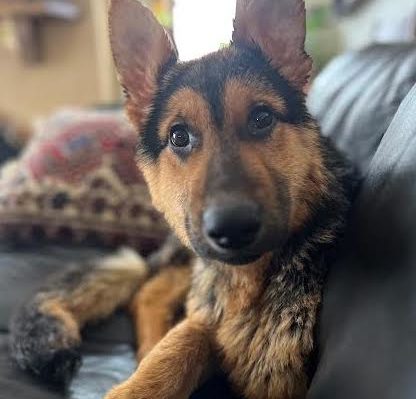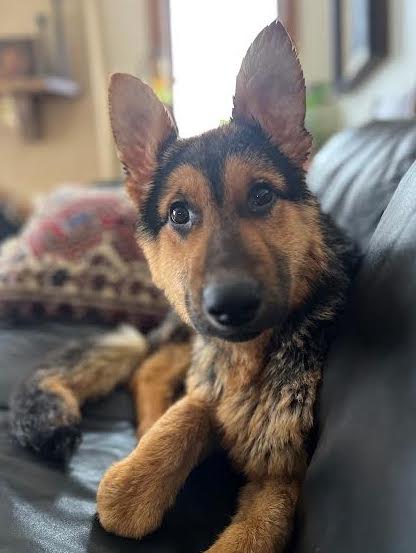
Recently, I got a request for advice from a local friend who’d helped her neighbor “rescue” a puppy that had been abandoned on a doorstep.
“I wanted to reach out for some advice. My neighbor across the street had someone leave a German Shepherd puppy on her porch in a tiny, filthy kennel. She bathed and fed her and we found a wonderful home for her with a young woman I work with. The puppy is having horrible separation anxiety. Every time she is left alone, she screams and cries. Do you have any suggestions on how to help her settle down? She’s the sweetest thing! She’s all vaxed and got a clean bill of health. She’ll get her last parvo shot in April. Vet said she was underweight but overall in good health. My workmate said the pup is filling out nicely.”

Photo Courtesy Of Julie Myklebust
I asked online for suggestions from dog professionals with specific expertise in dealing with separation anxiety. Here are some of their very important insights:
Colette Kase (Mexico) Make sure you have a proper diagnosis. Many dogs that vocalize or are destructive when left alone do not have separation anxiety.
Erika Liljefelt (California) As a Certified Separation Anxiety Pro Trainer, I recommend the following:
▪ Hire a trainer certified in helping dogs with separation anxiety/isolation distress (CSAT, SA Pro Trainer). There is a ton of outdated information and misinformation out there and a trainer can help you wade through all of that. They are trained to see things that most people don’t see. There are programs that are DIY, but make sure they were put together by a certified trainer. (It can be really helpful to work with a certified trainer for a bit even if you eventually plan to DIY.) An up-to-date trainer does not push the dog over threshold. They don’t push the dog to their limit to see how long it takes the dog to stop barking, whining, crying, etc. They teach you how to see the more subtle signs that tell you the dog is starting to feel anxious.
▪ A dog may have separation anxiety (hyper-attached to one person or family members) or isolation distress (can’t be alone, but can do okay with another person and sometimes another dog or even a cat. But I do not recommend getting another pet to help with SA/ID). The training is the same, but with ID, the people have more support options.
▪ Most importantly, suspend all absences.
▪ Confinement in a crate/pen/room is difficult for the majority of dogs with SA/ID, so take that out of the equation if there is even a question about it.
▪ We no longer use food to distract the dog. Many dogs won’t eat. Some dogs will eat but then panic when the food is gone. You can ruin certain foods or food toys if they become a departure cue for the dog that you are leaving.
▪ The key is slow desensitization training to absences at the dog’s pace. You can’t rush it. We don’t recommend leaving the dog for x number of minutes each day so they “get used to it,” as that can further sensitize them. The key to the desensitization training is that you move forward ONLY if the dog aces each session. You never “push through” to see how the dog does.
▪ Don’t start by trying to desensitize the dog to pre-departure cues like putting on shoes/jacket, picking up keys/purse, etc. Start with desensitizing them to your approaching the door (the door is a bore) and then work toward very short absences because your leaving is what the dog is afraid of, not your putting on shoes. Once you have a longer absence duration built up, only then start adding in one pre-departure cue at a time, starting with the least triggering.
▪ Learn dog body language. Learn what your dog’s body language looks like when they are not anxious, then learn what it looks like when they are anxious. Knowing the more subtle signs is the key to helping your dog make progress.
▪ Do talk to your vet about anti-anxiety medication as a first resort, not a last resort. We know meds work, but sometimes it takes time to figure out the correct med/combo of meds. SA is a medical emergency and should be thought of like any other medical emergency.
▪ You don’t have to ignore your dog. Make coming and going casual. If they come to you for reassurance, definitely reassure them calmly.
▪ You did not cause your dog’s SA/ID. We often don’t know why a dog has SA/ID. We are learning that it can be genetic in some cases.
Julie Naismith’s Be Right Back podcast is an incredible resource. Also, her book Be Right Back: Puppy Separation Anxiety Edition.
Marilyn Marks (Connecticut) There is nothing simple about treating real separation anxiety.
Khris Erickson (Wisconsin) I’m an SA Pro. Many times when dogs are crated they can exhibit behavior that looks like separation anxiety, but is actually confinement anxiety.
Before you know what to do as far as treatment goes, you have to make sure you have a correct diagnosis. I would set up a camera and leave the puppy for five minutes and see what happens.
In the beginning, you may see very subtle signals, so it may not be the big signals that most people associate with separation anxiety. Some of the things that would indicate separation anxiety are vocalizations such as barking and howling, scratching at the door, casing back and forth from the door to the window or circling, panting, drooling, and more subtle signals such as lip licking and yawning.
Typically the dog will spend the majority of its time at the door where the owner left.
If it truly is separation anxiety, the owner should find professional help to correctly assess the dog’s trigger point and come up with a desensitization protocol. Additionally, it’s highly recommended that the owner not leave during the training period except for training absences. The reason for this is that you’re trying to reframe the dog’s experience when left alone from one of severe anxiety to one of feeling relaxed.
I also like to work on building the dog’s independence and confidence. Positive training methods teaching tricks, enrichment activities, appropriate puzzle toys for the dog skill level, providing challenges for the dog to work through with the owner’s help, are all things that can help a dog develop resilience, which in turn will assist in overcoming separation anxiety.
Isabel Alvarez Arata (Texas) Having a dog with separation anxiety is a lifelong commitment (the dog’s life). Malena DeMartini is the subject-matter expert and uses positive-based techniques not only to address the issue but also to honor the bond between the human and their pet. I would immediately recommend this course: Mission POSSIBLE—Training Dogs with Separation Anxiety
Steven Cogswell (Colorado) This rarely just gets better on its own, nor are there any quick fixes. You need the help of a specialist. Malena DeMartini or Julie Naismith are the go-to folks. They both have books, websites, online programs, podcasts, and trainers they’ve trained for this. Working one-on-one with an SA trainer is ideal, but any of these resources will get them headed in the right direction.
Alisha Ardiana (California) I think a lot of people don’t recognize the dog needs to learn how to settle in their presence before they can settle in their absence.
How To Prevent Dog Separation Anxiety When You Return To Work
Separation-Related Problems: Anxiety Is Not the Only Cause
Terrie Hayward (British Virgin Islands)
1. Suspend absences
2. Liaise with vet as most cases are a combo of training + meds
3. Approximate/vary departures leading to duration and ultimately incorporating PDQs
4. Take my course!
Kate LaSala CTC CSAT (Connecticut) I am a CSAT and have numerous blog posts about SA. There are no quick fixes. The best thing to do is suspend absences so the dog doesn’t get worse and continue to panic. But I will say, many people misdiagnose SA. Your dog doesn’t have SA if they follow you around the house or sit outside the bathroom. I have lots of resources available but I’ll point out two:
I have a self-paced foundational course available here, and a free download, 5 Suggestions That Won’t Help Separation Anxiety (and Might Make It Worse)
If the dog truly has SA (diagnosed by a vet), then real pharmaceuticals are warranted, not CBD, not “natural” supplements. I write about that here.
And, if the dog is crated, it’s possible it’s not SA but confinement anxiety.
I would like to reiterate Colette Kase’s wise words:
Make sure you get a proper diagnosis.
▪ Visit your veterinarian with a focus on discussing your dog’s diagnosis: Is it separation anxiety?
▪ Video your dog for five minutes after you leave; send the video to your vet before the appointment.
▪ Ask your veterinarian to recommend expert guidance to help you deal with your dog’s diagnosis.
▪ Consider medication to address the diagnosis if your veterinarian feels that medication could help.



